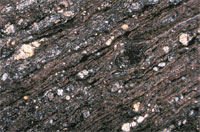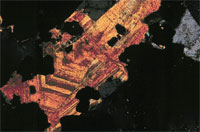Projects:
Topics and Schedule
Wed, April 27
Kevin McKenzie
Title: An Investigation into the Ferrar Dolerites from West Antarctica
Abstract: The Ferrar Dolerites span a long range when it first intruded into Gondwana, I will be using various methods including XRF and Optical Microscopy to help determine whether or not there is a variant among the samples. There will be 4 samples that span roughly 70 miles of distance from each other that were located in the Dry Valleys of West Antarctica.
Kalyleigh Alme
Title: Petrographic Investigation of Sudbury Impact Layer Material from Thunder Bay, Ontario, Canada
Abstract: The goal of this project was to determine some of the mineralogy of Sudbury Impact ejecta collected from Thunder Bay, Ontario using SEM and petrographic analysis.
Melissa Maertens
Title: Measuring Shear Stress in Mylonites from Argentina
Abstract: My project aims to interpret the shear stress on the mylonites of Argentina. I will interpret shear direction and hopefully I can calculate the approximate shear force applied. I will also provide basic background on mylonites in my presentation.
Tyler Kuehn
Title: Layered Petrology and Solidification Temperature for a Kileaua Pahoehoe Lava Flow Sample
Abstract: Determine the petrology (using XRF and Thins Section) of each of the layers: the glassy rind, transition zone, and the crystalline interior. Determine the Temperature of cooling of the glassy rind based on the methods of Helz and Thornber, using the MgO and CaO oxide weight percents in the glass.
Andrea Oswald
Title: Chemical Analysis of an Anorthosite Inclusion near Silver Bay, Minnesota
Abstract: An outcrop located near the town of Silver Bay, MN is host to an intrusion of diabase and inclusions of anorthositic rocks. Researchers gathered samples from this area and performed various laboratory experiments, on the anorthosites, to determine the whole-rock chemistry, through XRF analysis and thin sections. The estimated plagioclase composition was hypothesized using the Michel-Levy method by measuring the extinction angles of specific crystals. Results were analyzed and compared to a major piece of literature by Dr. Morrison and others. A formal presentation of results and comparisons is scheduled for the following week.
Thursday, May 28
Ben Osman
Title: Thermobarometry of a Schist from the Black Hills, South Dakota
Abstract: The Garnet schist found in the Black hills region of South Dakota, is a medium grade metamorphic rock that was originally a sedimentary rock. It was altered by an igneous granite plumb in the region that is now exposed and dated to Precambrian times.
With the use of data collected using SEM-EDS I will attempt to study the temperature and pressure of the rock at the time it was altered. In order to study this I will use a technique that is known at Geothermobarometry which is the calculation of equilibrium temperatures and pressures from the measured distribution of elements between coexisting phases (Winter, 2010).
Ariel Adolphsen
Title: Petrography and Geochemistry of Vesuvius Lava Samples
Abstract: The question of what makes Mount Vesuvius different and how to test it will be investigated.
Brady Folkestad
Title: Geochemistry and Mineralogy of the Bridal Veil Falls Intrusion, Black Hills, South Dakota
Abstract: The Bridal Veil Falls intrusion seems to be a fine grained, phaneritic, green and white nepheline syenite that contains large amounts of biotite in certain hand samples. The sample I collected has significantly less biotite than the previously collected samples (all samples were collected from the same intrusion, but from different areas within the intrusion). If this is the case there would be alkali feldspar instead of quartz because of the reaction nepheline undergoes with quartz.
I want to compare what Kirchner thought the rock was, and what I thought the rock was, with the data collected with XRF and SEM.
Jacob Crompton
Title: Ore Mineralogy, Red Dog Deposit, Alaska
Abstract: The Red Dog Mine is a lead-zinc sulfide mine located in northwestern Alaska near Kotzebue on the southern portion of the Brooks Range. Samples are investigated using SEM-EDS analysis.
Tues, May 3
Jenna Fischer
Title: Major and Trace element analysis of Parent Rock Diabase in Relation to Anorthosite intrusions, Minnesota
Abstract: Major and Trace element analysis of Parent Rock Diabase in Relation to Anorthosite intrusions, Minnesota, with emphasis on the relation of plagioclase composition using the Michel- Levy method to find heat and pressure of crystallization and therefore depth of the mafic intrusion.
Objectives: To understand the Major and Trace elements of Diabase using a XRF machine and thin section. Also, to understand how this relates to other mafic intrusions of the Duluth complex using literature. Then to compare these results with the composition of the Anorthosite intrusions to see how the two rocks relate. Finally, attempt to use the plagioclase of the Diabase and Anorthosite with the Michel- Levy method to find pressure and heat of crystallization and therefore depth of the crystallization of the intrusion.
Sean Ternes
Title: Ore Mineralogy and Geochemistry of the Midas Mine in Northern Nevada
Abstract: The Midas Mine is a gold and silver mine located in the northern Nevada Rift. The deposits are low-sulfidation epithermal gold and silver deposits. The goal of this project is to determine the specific mineralogy and geochemistry of the ore deposits from the Midas Mine in the Carlin Trend of northern Nevada. Identification of gold and silver bearing minerals and understanding their geochemistry is important for the exploration of other ore deposits.
Gabe Ferragut
Title: Analysis of Mt. Erebus Volcanics: A Possible Anorthoclase Phonolite with Melt Inclusions
Abstract: I would like to analyze inclusions in the Mt. Erebus lava samples and compare them to literature on anorthoclase inclusions from Mt. Erebus melt. This would be done through both thin sections and SEM and from this Ar amounts could also be looked at and compared possibly. Based on the chemistry of the matrix and the chemistry of the inclusions I would like to attempt to learn more about the formation of the feldspar inclusions. Specifically I am interested in whether or not they are formed as part of an eruptive process, within plume rising, and if so, at what depth/temperature/pressure.
Genia Cegla
Title: Mineralogy and Geochemistry of a Sample of the Pikes Peak Batholith
Abstract: For my project I will be studying a sample of the Pikes Peak batholith from the entrance of Pikes Peak Highway in Colorado Springs, CO. I want to create a thin section in order to look at the minerals found and their general abundances in my sample. I will also crush up my rock and use XRF to get a chemical analysis of the rock. I can then use this data to plot on a TAS diagram and compare my results to literature reports.






